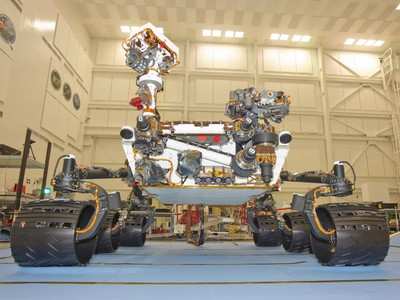Mon, Jun 27, 2011
NASA's Next Mars Rover Arrives At KSC From CA. Launch
Preparations Begin For Fall Mission
The Mars Science Laboratory rover, also known as Curiosity,
arrived late Wednesday night at NASA's Kennedy Space Center aboard
an Air Force C-17 transport plane. It was accompanied by the
rocket-powered descent stage that will fly the rover during the
final moments before landing on Mars. The C-17 flight began at
March Air Reserve Base in Riverside, CA, where the boxed hardware
had been trucked from NASA's Jet Propulsion Laboratory in Pasadena,
CA.

Curiosity Arrives On C-17 Transport
The rover's aeroshell -- the protective
covering for the trip to the Red Planet -- and the cruise stage,
which will guide it to Mars, arrived at Kennedy last month. The
mission is targeted to launch from Cape Canaveral Air Force Station
between Nov. 25 and Dec. 18. The car-size rover will land on Mars
in August 2012.
"The design and building part of the mission is nearly behind us
now," said JPL's David Gruel, who has managed Mars Science
Laboratory assembly, test and launch operations since 2007. "We're
getting to final checkouts before sending the rover on its way to
Mars."

Curiosity Before Shipping
The rover and other spacecraft components will undergo more
testing before mission staff stack them and fuel the onboard
propulsion systems. Curiosity should be enclosed in its aeroshell
for the final time in September and delivered to Kennedy's Launch
Complex 41 in early November for integration with a United Launch
Alliance Atlas V rocket.
Curiosity is about twice as long and more than five times as
heavy as any previous Mars rover. Its 10 science instruments
include two for ingesting and analyzing samples of powdered rock
delivered by the rover's robotic arm. During a prime mission
lasting one Martian year -- nearly two Earth years -- researchers
will use the rover's tools to study whether the landing region has
had environmental conditions favorable for supporting microbial
life and favorable for preserving clues about whether life
existed.

Curiosity On Mars Artist's Rendering
JPL built the rover and descent stage and manages the mission
for NASA's Science Mission Directorate in Washington. Launch
management for the mission is the responsibility of NASA's Launch
Services Program at Kennedy. The California Institute of Technology
in Pasadena manages JPL for NASA.
More News
Light Gun A handheld directional light signaling device which emits a brilliant narrow beam of white, green, or red light as selected by the tower controller. The color and type of>[...]
"The journey to this achievement started nearly a decade ago when a freshly commissioned Gentry, driven by a fascination with new technologies and a desire to contribute significan>[...]
Aero Linx: JAARS, Inc. For decades now, we’ve landed planes on narrow rivers and towering mountains. We’ve outfitted boats and vehicles to reach villages that rarely se>[...]
"Our driven and innovative team of military and civilian Airmen delivers combat power daily, ensuring our nation is ready today and tomorrow." Source: General Duke Richardson, AFMC>[...]
Aircraft Conflict Predicted conflict, within EDST of two aircraft, or between aircraft and airspace. A Red alert is used for conflicts when the predicted minimum separation is 5 na>[...]
 ANN's Daily Aero-Term (04.20.24): Light Gun
ANN's Daily Aero-Term (04.20.24): Light Gun Aero-News: Quote of the Day (04.20.24)
Aero-News: Quote of the Day (04.20.24) ANN's Daily Aero-Linx (04.21.24)
ANN's Daily Aero-Linx (04.21.24) Aero-News: Quote of the Day (04.21.24)
Aero-News: Quote of the Day (04.21.24) ANN's Daily Aero-Term (04.21.24): Aircraft Conflict
ANN's Daily Aero-Term (04.21.24): Aircraft Conflict





